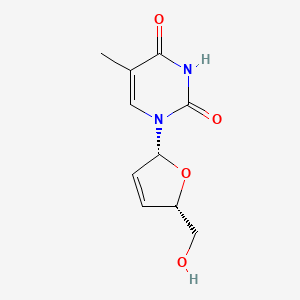D0113 | Stavudine
J
J05AR07 Stavudine, lamivudine and nevirapine
[J05AR] Antivirals for treatment of HIV infections, combinations
[J05A] DIRECT ACTING ANTIVIRALS
[J05] ANTIVIRALS FOR SYSTEMIC USE
[J] Antiinfectives for systemic use
J05AF04 Stavudine
[J05AF] Nucleoside and nucleotide reverse transcriptase inhibitors
[J05A] DIRECT ACTING ANTIVIRALS
[J05] ANTIVIRALS FOR SYSTEMIC USE
[J] Antiinfectives for systemic use
| Toxicity | Dose | Time | Species | Model | Method | Action | Positive criterion | Reference |
|---|---|---|---|---|---|---|---|---|
| MITOCHONDRIAL DNA | depletion | 197 | ||||||
| MITOCHONDRIAL DNA METABOLIC PROCESS | 194 | |||||||
| Target | Dose | Time | Species | Model | Method | Action | Positive criterion | Reference |
|---|---|---|---|---|---|---|---|---|
| DNA polymerase gamma | 194 | |||||||
| Pictogram | Signal | Statements | Precautionary Statement Codes |
|---|---|---|---|
  |
Danger |
Aggregated GHS information provided by 3 companies from 3 notifications to the ECHA C&L Inventory. Each notification may be associated with multiple companies. H302 (66.67%): Harmful if swallowed [Warning Acute toxicity, oral] H315 (33.33%): Causes skin irritation [Warning Skin corrosion/irritation] H319 (33.33%): Causes serious eye irritation [Warning Serious eye damage/eye irritation] H335 (33.33%): May cause respiratory irritation [Warning Specific target organ toxicity, single exposure Respiratory tract irritation] H341 (33.33%): Suspected of causing genetic defects [Warning Germ cell mutagenicity] H361 (33.33%): Suspected of damaging fertility or the unborn child [Warning Reproductive toxicity] H362 (33.33%): May cause harm to breast-fed children [Reproductive toxicity, effects on or via lactation] H372 (33.33%): Causes damage to organs through prolonged or repeated exposure [Danger Specific target organ toxicity, repeated exposure] Information may vary between notifications depending on impurities, additives, and other factors. The percentage value in parenthesis indicates the notified classification ratio from companies that provide hazard codes. Only hazard codes with percentage values above 10% are shown. |
P201, P202, P260, P261, P263, P264, P270, P271, P280, P281, P301+P312, P302+P352, P304+P340, P305+P351+P338, P308+P313, P312, P314, P321, P330, P332+P313, P337+P313, P362, P403+P233, P405, and P501; (The corresponding statement to each P-code can be found at the GHS Classification page.) |
| Organism | Test type | Route | Dose (normalized dose) | Effect | Source |
|---|---|---|---|---|---|
| mouse | LD50 | oral | 1gm/kg (1000mg/kg) | Gekkan Yakuji. Pharmaceuticals Monthly. Vol. 40, Pg. 1944, 1998. | |
| rat | LD50 | intravenous | > 1200mg/kg (1200mg/kg) | Gekkan Yakuji. Pharmaceuticals Monthly. Vol. 40, Pg. 1944, 1998. | |
| dog | LD | oral | > 2gm/kg (2000mg/kg) | gastrointestinal: nausea or vomiting | Gekkan Yakuji. Pharmaceuticals Monthly. Vol. 40, Pg. 1944, 1998. |
| dog | LD | intravenous | > 1680mg/kg (1680mg/kg) | gastrointestinal: nausea or vomiting | Gekkan Yakuji. Pharmaceuticals Monthly. Vol. 40, Pg. 1944, 1998. |
| rat | LD50 | oral | 4gm/kg (4000mg/kg) | Gekkan Yakuji. Pharmaceuticals Monthly. Vol. 40, Pg. 1944, 1998. | |
| mouse | LD50 | intravenous | 1gm/kg (1000mg/kg) | Gekkan Yakuji. Pharmaceuticals Monthly. Vol. 40, Pg. 1944, 1998. | |
| 056S175 | 1-((2R,5S)-5-(hydroxymethyl)-2,5-dihydrofuran-2-yl)-5-methylpyrimidine-2,4(1H,3H)-dione | 1-((2R,5S)-5-Hydroxymethyl-2,5-dihydro-furan-2-yl)-5-methyl-1H-pyrimidine-2,4-dione |
| 1-(2,3-Dideoxy-.beta.-D-glycero-pent-2-enofuranosyl)thymine | 1-(2,3-Dideoxy-beta-D-glycero-2-pentenofuranosyl)thymine | 1-(2,3-Dideoxy-beta-D-glycero-pent-2-enofuranosyl)thymine |
| 1-(5-Hydroxymethyl-2,5-dihydro-furan-2-yl)-5-methyl-1H-pyrimidine-2,4-dione | 1-(5-Hydroxymethyl-2,5-dihydro-furan-2-yl)-5-methyl-1H-pyrimidine-2,4-dione (ddeThd) | 1-(cis-5-(Hydroxymethyl)-2,5-dihydrofuran-2-yl)-5-methylpyrimidine-2,4(1H,3H)-dione |
| 1-[(2R,5S)-2,5-Dihydro-5-(hydroxymethyl)-2-furanyl]-5-methyl-2,4(1H,3H)-pyrimidinedione | 1-[(2R,5S)-5-(HYDROXYMETHYL)-2,5-DIHYDROFURAN-2-YL]-5-METHYL-1,2,3,4-TETRAHYDROPYRIMIDINE-2,4-DIONE | 1-[(2R,5S)-5-(Hydroxymethyl)-2,5-dihydrofuran-2-yl]-5-methylpyrimidine-2,4-(1H,3H)-dione |
| 1-[(2R,5S)-5-(hydroxymethyl)-2,5-dihydrofuran-2-yl]-5-methyl-pyrimidine-2,4-dione | 1-[(2R,5S)-5-(hydroxymethyl)-2,5-dihydrofuran-2-yl]-5-methylpyrimidine-2,4(1H,3H)-dione | 1-[(2R,5S)-5-(hydroxymethyl)-2,5-dihydrofuran-2-yl]-5-methylpyrimidine-2,4-dione |
| 1-[5-(hydroxymethyl)-2,5-dihydro-2-furanyl]-5-methyl-2,4(1H,3H)-pyrimidinedione & Colony-stimulating factor 2 | 2'',3''-didehydro-3''-deoxythymidine | 2'',3''-dideoxy-2'',3''-didehydrothymidine |
| 2',3'-Anhydrothymidine | 2',3'-Anhydrothymidine | 2',3'-DIDEHYDRO-3'-DEOXYTHYMIDINE (DDI) |
| 2',3'-Didehydro-3'-deoxy-thymidine | 2',3'-Didehydro-3'-deoxythimidine | 2',3'-Didehydro-3'-deoxythymidine |
| 2',3'-Didehydro-3'-deoxythymidine, >=98% (TLC) | 2',3'-didehydro-2',3'-dideoxythymidine | 2'-Thymidinene, 3'-deoxy- |
| 220020-60-0 | 3''-deoxy-2'',3''-didehydrothymidine | 3''-deoxy-2''-thymidine |
| 3'- Azido-3'-deoxythymidine & Granulocyte-macrophage colony-stimulating factor | 3'-Deoxy-2',3'-didehydro-D-thymidine | 3'-Deoxy-2',3'-didehydrothymidine |
| 3'-Deoxy-2',3'-didehydrothymidine, 98% | 3'-Deoxy-2'-thymidinene | 3'-deoxythymidin-2'-ene |
| 3056-17-5 | A820433 | AB0013374 |
| AB00383018_18 | AB1009564 | ABP000995 |
| AC-5263 | AKOS005622554 | ANW-26914 |
| BBL033763 | BCP02952 | BDBM50013111 |
| BIDD:GT0082 | BMY 27857 | BMY-27857 |
| BO9LE4QFZF | BR-77340 | BRN 0618327 |
| C07312 | CAS-3056-17-5 | CCG-100902 |
| CHEBI:63581 | CHEMBL991 | CPD000058350 |
| CPD000673569 | CS-1872 | CTK8B1419 |
| D 1413 | D 4T | D 4T (nucleoside) |
| D00445 | D3580 | D4T & GM-CSF |
| D4TMBY-27857-3 | DB00649 | DSSTox_CID_3819 |
| DSSTox_GSID_23819 | DSSTox_RID_77198 | DTXSID1023819 |
| Dideoxydidehydrothymidine | EU-0100336 | Estavudina |
| Estavudina [INN-Spanish] | FT-0082665 | FT-0603625 |
| H940 | HMS2051O20 | HMS2234C10 |
| HMS3039O05 | HMS3259L21 | HMS3261C13 |
| HMS3428C07 | HMS3714N22 | HSDB 7338 |
| HY-B0116 | J-700246 | J10003 |
| KS-00000H34 | KS-1115 | LP00336 |
| LS-1160 | Lopac0_000336 | MCULE-9252477726 |
| MFCD00132921 | MLS000028546 | MLS000759504 |
| MLS001055348 | MLS001077292 | MLS001424091 |
| MLS006011922 | NC00152 | NC00684 |
| NCGC00023212-03 | NCGC00023212-04 | NCGC00023212-05 |
| NCGC00023212-07 | NCGC00023212-08 | NCGC00023212-09 |
| NCGC00023212-10 | NCGC00023212-11 | NCGC00023212-12 |
| NCGC00023212-13 | NCGC00023212-14 | NCGC00254372-01 |
| NCGC00258944-01 | NCGC00261021-01 | NSC 163661 |
| NSC-759897 | NSC163661 | NSC759897 |
| Opera_ID_1281 | Pharmakon1600-01502339 | PubChem5805 |
| Q-201742 | Q423984 | S-2155 |
| SAM001246729 | SAM002589948 | SC-03292 |
| SCHEMBL38661 | SMR000058350 | SMR000673569 |
| SR-01000075802 | SR-01000075802-1 | SR-01000075802-4 |
| STK801888 | STV | Sanilvudine (JAN) |
| Stavudin | Stavudine (USAN/INN) | Stavudine (d4T) |
| Stavudine [USAN:BAN:INN] | Stavudine [USAN:INN:BAN] | Stavudine [USAN:USP:INN:BAN] |
| Stavudine for system suitability, European Pharmacopoeia (EP) Reference Standard | Stavudine, European Pharmacopoeia (EP) Reference Standard | Stavudine, United States Pharmacopeia (USP) Reference Standard |
| Stavudinum | Stavudinum [INN-Latin] | Thymidine, 2',3'-didehydro-, 3'-deoxy- |
| Thymidine, 2',3'-didehydro-3'-deoxy- | Thymine, 1-(2,3-dideoxy-beta-D-glycero-pent-2-enofuranosyl)- (7CI,8CI) | Tox21_110886 |
| Tox21_110886_1 | Tox21_201393 | Tox21_300583 |
| Tox21_500336 | UNII-BO9LE4QFZF | XNKLLVCARDGLGL-JGVFFNPUSA-N |
| Z1695906749 | ZINC137884 | Zent |
| Zerit | Zerit (TN) | Zerit Xr |
| Zerit(TM) | Zerut XR | cid_18283 |
| cid_5155 | d4T | d4T |
| ddeThd | ddeTyd | sanilvudine |
| stavudine |

